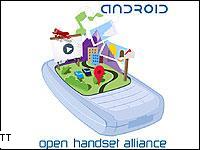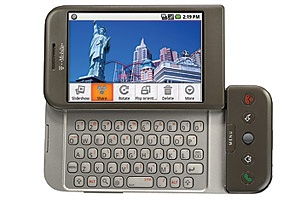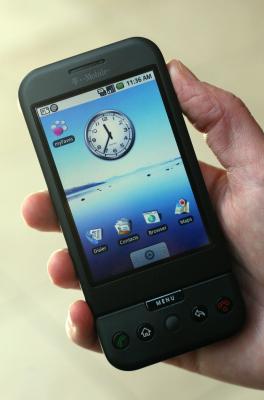Posts tagged ‘Android’
Motorola to opt for Android OS
Sources in India have mentioned that Motorola is soon going to opt for Google’s Android as operating system for its new range of phones. On the other hand, business-focused devices will be based on Microsoft Windows Mobile. The company however, will continue to use its own platform, P2K for low-end phones. The company is also looking to outsource production of some windows Mobile phones.
Vishal
Notes from Wireless Technology Forum SIG on Wireless Apps and Mobile Media (WAMM), Atlanta 10-09-2008
I attended the Wireless Tech Forum Meeting today at The Ashford Club, Atlanta. Today’s topic was Wireless Applications and Mobile Media. This is a new Special Interest Group within the Wireless Tech Forum and organizers have done a great job as usual of creating format and content for this SIG. Steve Bachman heads up the WAMM SIG along with co-chairs Richard Yates and Ed Pimentel.
Today we had an excellent first session on mobile media with a great presentation by Jerry Rocha, the Sr Director of Mobile Research at Nielsen Mobile (formerly Telephia). Jerry presented some great information on patterns, trends, usage stats on mobile media and mobile apps. Here are some highlights from the session :
Among major apps on the mobile data gravy train are SMS, mobile apps and mobile internet. We have to see which one comes out ahead in terms of user adoption but all are growing with heady growth rates compared to where they were before (of course we are only talking US market in this entire discussion, I know mobile data in Europe and Asia is a totally different ballgame and growth pattern).
Number Crunching :
If we include all mobile data, it is growing at rate of 28%. In Europe, SMS was big but with falling rates of SMS, carriers are pushing MMS which commands higher revenues. There were 260 million mobile customers in USA at end of Q2, 2008. Of which 56 million were downloading mobile apps. 15 million customers have seem video on mobile – small percent of mobile population but growing. Of the 260 million mobile customers in USA, 102 million have access to the mobile internet. 77% of mobile subscribers can get SMS today. Mobile internet is now a 1.2 billion dollar industry. 43 million customers in USA use mobile internet regularly now.
Trends :
Nielsen Mobile has access to 80,000 customers bills for market survey and this is the primary source of market research for Nielsen Mobile.
Among data apps, audio is a big killer app. Games was popular but there is decline in mobile gaming. Many fringe mobile gaming firms are going out of business with big ones like Glu Mobile and Electronic Arts taking majority of market share in mobile gaming. Ringtones are powerful but see slower traction now.
Mobile apps have see a huge uptick this year – one reason is the iPhone and the awareness it created about mobile apps in general.
From a strategy perspective, media firms like CNN, ESPN and others have pushed mobile media in spite of lack of enough support from carriers. Media firms are pushing off-deck content.
Mobile Internet :
Mobile portals are most heavily visited area. Email is second most popular with 27.4 million users (Nielsen is not including POP3 email accounts). Among sites visited most, the order is : Yahoo (22.3 million users), Google (18.9 million), MSN (14.4 million), AOL (12.6 million), Weather Channel, CNN, FOX, Apple, Turner in that order.
iPhone has been a game changing device for mobile internet with each firm now forced to follow a three pronged internet strategy : Regular website, Mobile website and iPhone-optimized website. Many firms have device detection and render appropriate website based on source of access.
Mobile Apps :
These have seen a giant increase since Q1 of this year. Most popular apps are related to LBS (Location-Based Services) – an area for which we in CellStrat have written extensively and have a nice white paper on our company website (www.cellstrat.com). Top 10 mobile apps are (in declining order of popularity) :- Verizon Navigator, Sprint Navigator, AT&T Navigator, Wireless Synch Email, TeleNav GPS Navigator, Sprint Family Locator, MySpace Mobile, Mobile Email, MapQuest Mobile and XM Radio Mobile.
Lot of firms like Nokia are buying up firms which have LBS offerings or technology.
Some of the big publishers of mobile apps are : TeleNav Mobile, Networks in Motion, Intellisync, WaveMarket, MySpace Mobile, AutoDesk etc.
It seems Location tracking is an app whic commands $5 per month revenue relatively easily. Same cannot be said for some of the other mobile apps though.
The top mobile app areas in order of popularity are (most popular first) :- LBS (69% of mobile apps are related to this), PIM Tools, Weather, Music, Maps or Directions etc.
iPhone :
This has shaken the mobile world as we report countless times now. Apple iPhone now as 1% of USA market share and 3.7% of AT&T mobile phones are iPhones. By Q3, Apple had sold 10 million iPhones worldwide easily hitting its goal of 10 million iPhones in first year.
iPhone AppStore is a breakthrough concept and has opened up the mobile application ecosystem to developers like never before. In the 4 months since its launch, iPhone AppStore has seen 100 million downloads of mobile apps, total number of mobile apps on iPhone available now exceeds 3000 apps.
iPhone dominates every category of mobile web usage.
Some cool iPhone killers like BlackBerry Bold, Storm and Google G1 are out or coming out soon and we will have to see how well they do against iPhone. One reason for huge app success on iPhone is its excellent developer support and ecosystem eg the iTunes store. Nokia scores well too on this front with its Symbian platform.
iPhone users skew towards male with 67% iPhone users being males and 33% females although in overall mobile world, 52% of mobile customers are females.
Mobile Advertising :
This one pays for it all.
Interestingly Atlanta is No 3 in mobile video usage (interesting..never thought Atlanta was that big on mobile web adoption). Among mobile email, gmail and yahoo email dominate.
Nielsen has tools to scrap 300 websites every 15 minutes and categorizes them for ad purposes. It turns out Eletronic Arts and Dunkin Donuts are bigger advertisers in mobile internet. On ESPN Mobile, Electronic Arts is the biggest advertiser.
Dream WiMAX Phone Coming to Russia
Imagine having access to broadband speeds on your phone without the need for a WiFi hotspot. Yes, such a phone is soon going to be launched in Russia. Dates are not know however, according to floating news, it will be soon enough. In addition to a WiMax radio, the device will have WiFi, tri-band GSM, microSD, dual cameras, 3.5mm audio, an A/V plug and a gargantuan 850 x 480 screen, which should blow the iPhone away.
You can read the full story here.
gPhone or G1 – Google’s Android-based phone emerges
Well…here comes G1 – Google’s Android phone from T-Mobile USA. This is the iPhonesque phone from Google running its Android operating system and manufactured by HTC of Taiwan. Incidentally, it is also the first Android phone, Android being the Open Source Mobile Operating System being promoted by Google via its Open Handset Alliance (OHA).
G1 is available from T-Mobile USA from Oct 22 for $179 (with a 2 year contract) but the carrier is pre-selling the phone from today.
Take a look :
It looks nice. Does it compare with iPhone. It comes close but still does not beat iPhone sleekness. What about software ? We still need to see if the Android and all the Google apps loaded on it do any magic beyond the benchmark set by iPhone and its amazing software and application ecosystem. Android is supposed to create a great mobile software ecosystem similar to Apple and its iPhone environment.
For those who were holding out on buying an iPhone could take a shot at this one. But we doubt any iPhone owners out there would switch. iPhone 3G is just too good. Well we will see once we see adoption of the new Google phone. This is supposedly running the Google’s new shiny Chrome browser (actually Chrome Lite – mobile version of Chrome).
Some key Android features : openness – developers can develop application extensions to Android using its publicly available API. The G1 comes with maps, e-mail (gmail), instant messaging, music player and a camera. There is an Android Application store similar to the iPhone App Store. Google’s USP against the iPhone seems to be openness and willingness to let developers work more freely with Android as compared to the Apple’s tighter control over the iPhone application ecosystem. It could be a double-edged sword. Openness has its pros and cons. As to iPhone App Store, since its launch in July, users have downloaded more than 100 million applications for the iPhone and the iPod touch. Google has run Android developer challenge contest to get developers to create more Android apps.
For more details on G1, go to T-Mobile G1 site.
Welcome to the world of superphones. Superphone – a term informally being used for the ultra smart and ultra sleek new smartphones. This is a new world. We love this, finally mobile world is coming around with some cutting edge device and software innovation. Next we await the BlackBerry Bold – RIM’s answer to the iPhone and Google phone.
One thing is for sure. The new superphone world belongs to Apple, Google, RIM and Nokia. What about the rest ?
From a mobile OS perspective, there is a fight between Android, iPhone, Symbian, Windows Mobile, LiMo etc. Talk about fragmentation. Alas, if only developers could find a truly universal Mobile development ecosystem but without a PC-kind of monopoly.
MT
Android Market announced…
Only concern about the Android Market will be licensing, security and stability of the apps…
 Google’s Android developer community has announced Android Market, a service.
Google’s Android developer community has announced Android Market, a service.T-Mobile to Offer 1st Android
If all goes according to plan, T-Mobile USA will be the first carrier to offer a mobile phone based on Google’s Android software.
Vishal
Android And Symbian Sitting In a Tree: Suggested Merger Pretty Unlikely…
Analyst J. Gold has come out with a prediction that Symbian and Android will begin merging into one open source OS within 3-6 months, and it’s gotten a fair bit of airplay. The reasons?
— “Google’s (NSDQ: GOOG) investment in Android is “diluting the potential for it [Google] to build compelling cross-device applications where it can generate substantial revenues”.
— Symbian could get some cred with the open source community.
— Fewer platforms for the market, which would benefit everybody.
“A combination of the Android and Symbian efforts would be good for the industry, good for Google and good for Symbian,” J. Gold said. “It would also help spur a growth in the availability of applications and services. The downside is minimal. Everyone wins,” reports Information Week. It’s true that Symbian does need to attract unpaid developers to its open source effort, and it’s also true that Symbian CEO Nigel Clifford said that the organization would be happy to work with Google “on the application level or…could be on the more fundamental operating system level.”
WiMAX rises from the dust
WiMAX got a new lease of life yesterday in the developed world. Sprint announced a breakthrough agreement with ClearWire of Kirkland, Washington to create a joint venture under the name ClearWire but with 51% stake owned by Sprint, 27% by ClearWire investors and the remaining by some other high profile investors. Sprint is the third largest US wireless operator and is betting on WiMAX in 4G race as opposed to AT&T and Verizon, the two biggest US mobile operators, who are betting on GSM version of 4G called LTE or Long Term Evolution. WiMAX has the unique advantage over LTE as WiMAX equipment is available now and LTE is 2 years behind WiMAX.
The deal with ClearWire is a complex transaction with an alpha-soup list of investor firms participating including Comcast, Intel, Google, and cable operator Bright House Networks. Why are these firms interested ? Intel needs a new chip wave now that Centrino is everywhere already. Plus Intel has been investing in WiMAX chip development as the next evolution of the WiFi enabled chip. Google is the preferred search provider on ClearWire WiMAX devices and its Android platform will find a big network partner. Comcast and Bright House are looking for a way to expand into high speed mobile services and wireless broadband – now that AT&T and Verizon are beginning to erode cable market share with their own high speed TV offerings and innovative quad-play bundling of wireless, wireline, TV and internet. Essentially bundling is the new mantra for getting customers and cable providers need a wireless channel partner to cover this one missing piece in the cable package.
With this WiMAX deal, Sprint has one less thing to worry as it was coming from low cash liquidity position and needed money to launch a 4G offering – it got its wish fulfilled by getting some partners with big pockets to invest in its nascent 4G endeavour. Now it can go back to focusing or investing in its core CDMA business and in time make it attractive enough to sell to interested parties, eg Deutsche Telekom at a good price. Sprint Xohm service, its WiMAX trial launch service, is all but dead or in essence, will be merged into ClearWire. Sprint is taking a non-operating role in ClearWire and is talking about having ClearWire manage itself independently with separate wireless assets and separate management structure.
Well – the ClearWire deal looks interesting on the face of it and Sprint does have one less thing to worry about now that its WiMAX / 4G path is clear. But in reality, the challenges remain. With an alpha-soup combination of ClearWire investors, this firm will be chauffeured by multiple backers with sometimes varying agendas. Historically speaking, such complex deals have a high failure rate. Plus it remains to be seen if Sprint core CDMA service ends up competing with its WiMAX offering. We think success of ClearWire depends on letting it be a truly independent company with dedicated management and letting it compete openly.
In any case, WiMAX got a new lease on life. Now with this announcement, it will trigger a chain reaction and network equipment vendors like Nortel, Samsung, AirSpan, Lucent etc will make hay by selling WiMAX equipment. Intel will sell chips for WiMAX – PCs with WiMAX-enabled chips will be hot. More PC software will be sold. Google gets a mobile momentum on next generation wireless network. Cable firms have a high speed mobile partner. Nokia and other device makers will sell high end WiMAX phones. Consumers get truly personal mobile broadband everywhere, on their cellphones and laptops. They can potentially ditch their wired DSL or cable modems and replace it with wireless broadband. Everybody is happy at the end of the day. Lets see if this theory works or not. Regardless, the ClearWire announcement may trigger a larger WiMAX adoption in other developed countries. So far WiMAX growth story was limited to developing countries in Asia, Sprint announcement is a big boost to this technology in the western hemisphere.
MT


